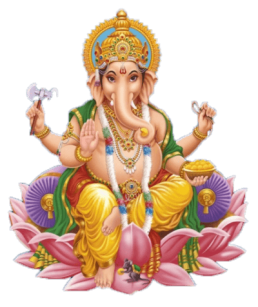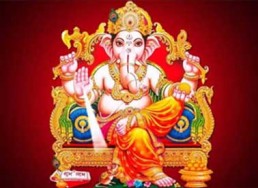Vakratunda
निर्विघ्नं कुरु मे देव सर्वकार्येषु सर्वदा ॥
nirvighnaṃ kuru me deva sarvakāryeṣu sarvadā
Vakra-Tunndda: Who has a curved trunk.
Maha-Kaaya: Who has a large body
Suurya-Kotti Samaprabha: Whose splendour is similar to a million Suns
Nirvighnam: (Please make my undertakings) free of obstacles
Kuru me Deva: Please make (please make my undertakings free of obstacles) O’ God
Sarva-kaaryessu: In all my works
Sarvadaa: Always

Description
This is a very popular prayer to Lord Ganesha, typically chanted at the beginning of any new undertaking or even any activity, where we seek Lord Ganesha’s blessings to pave the way for our desired undertaking to happen. This prayer can be chanted upon waking as well. The time or activity is less important. The sincerity with which we pray is what matters.
Visit our Ganesh Chaturthi home page for more information, Pooja videos and popular Lord Ganesh songs all Ad-Free!
Ganapati means “Lord of the people” (gana-“Host, group of people”, pati-“father, Lord”) and is also known as
Ganesha Gana-Esha, again referring to a Lord (Isha) of the Host/People.
Lord Ganesha, who is known as the Lord of New Beginnings, is also worshipped as the Remover of Obstacles.
Sri Swami Chinmayananda describes the symbolism of Lord Ganesha as follows:
The Lord of Obstacles, Sri Vighneswara has four arms representing the four inner equipments, the Anthahakarana(Mind, Intellect, Memory and Ego).
In one hand He has the ROPE and in the other He has an AXE. On the spiritual pilgrimage, all obstacles are created by the very subjective and objective worlds in the seeker himself. Sri
Vighneswara chops them off with the AXE. He cuts off the attachments of His devotees to the world of plurality and thus ends all the consequent sorrows. He holds the attention of the seeker constantly towards the Higher, and pulls us nearer and nearer to the Truth and ultimately ties him down to the Highest Goal with the ROPE. With one hand, He blesses all His devotees and protects (ABHAYA) them from all obstacles on their spiritual path of seeking the Supreme, and with the other hand He feeds the seeker with MODAKA, representing the reward of the joys of sadhana — the “Joy of Experiencing the Reality”.
Sri Sai Baba on Significance of Vinayaka Worship
By Sri Sathya Sai Baba
The following are a few more salient features of Ganesha’s symbolism that we ought to know
1. He is the first God to awaken in our consciousness and the first God to preside over our inner transformation.
2. As Vighneswara, the remover of obstacles, he removes ignorance, the biggest obstacle in our spiritual transformation.
3. Seated in the Muladhara chakra, he opens the blockages of inertia (tamas) present in the body and facilitates the passage of Kundalini and the free flow of spiritual energy.
4. As the harbinger of good, messenger of God and lord of the divinities, he fulfills the desires of his devotees and opens to them the doors of prosperity and abundance.
5. He is not only the son of Siva but also of Parvathi (nature). Since he is born out of their union, he personifies life, duality and manifestation in its diverse aspects.
5. His vehicle is the lowly mouse. His association with it symbolizes his lordship or control over fear, hesitation, weakness, doubt and nervousness, which the mouse symbolizes. He removes these obstacles to facilitate success and achievement for those who pray to him.
6. Lord Ganesha is the enjoyer of food. As the eater of various forms of food, he symbolizes Brahman, the ultimate recipient of all sacrificial offerings, In the body he symbolizes the individual Self, which is described in the Vedas as the enjoyer and the witness consciousness.
7. Lord Ganesha is the lord of Siva ganas. In the body, the ganas symbolize desires, thoughts and impulses. They are responsible for the instability and the modifications of the mind. They are also responsible for our distractions and failures in life. As their lord, Ganesha helps us in stabilizing our minds and experiencing peace and sameness.
Lord Ganesha is our friend and benefactor in the fulfillment of the four aims of human life, namely duty (dharma), wealth (artha), enjoyment (kama) and liberation (moksha). He helps both the householders as well as the ascetics in realizing their goals. He is also described as a galactic god, who keeps balance among various worlds. He is the true son of God, Isvara, the Lord of the Universe.
Other Ganesha Shlokams
Agajanana Padmakam
We meditate day and night on the one-tusked one who is the sun for the lotus in the form of the face of Pārvatī, the one with the elephant face and the one who is the giver of all desired ends to his
Gajananam Bhuta
I bow to you, the Lord with the face of an elephant (Gajanana), one who is served by the celestial attendants (Bhoota ganas) and other beings. The one who consumes the extract of Kapitha (wood apple)
Gananamtva Ganapatim
Among the celestial attendants (Ganas), you are the Lord (Ganapathi), We offer sacrificial oblations to you You are the wisest among the scholars. Your wisdom is known to be highest quality and uncomp
Ganapathi Atharvashirsha
The Ganapati Atharvasirsha Upanishad is a Sanskrit text and a minor Upanishad of Hinduism. It is a late Upanishadic text dedicated to Ganesha, the deity representing intellect.
Ganapati Stotram
As the rays from the lotus-face of Gauri (Devi Parvati) is always on her beloved son Gajanana (Who has the face of an Elephant), Similarly, the grace of Sri Ganesha is always on his devotees; Granting
Ganesh Chathurthi
Significance of Ganesh Puja, Vinayaka Chavithi or Chathurthi. See how to prepare for Ganesha Pooja, How to perform the Puja with Video instructions and enjoy Audio devotional songs, uninterrupted and without ads.
Ganesha Gayatri Mantra
We pray to the one-tusked; we meditate on the one having a twisted trunk. May that Ganapati (one-tusked) inspire us (to meditate).
Ganesha Pancharathnam
The composer, Guru Sri Adi Shankaracharya had praised the God Ganesha by presenting these five stanzas as five jewels, hence the name Maha Ganesha Pancharatnam.
Ganesha Stavah
Ganesha Stavah or Ganapati Stavah is a set of 13 verses that describe the glory of Lord Ganesha. Gaṇapati stavaḥ is said to be from Ganesh Purana - upāsanā khaṇḍa adhyāya 13.
Mooshika Vahana
Salutations to Sri Vighna Vinayaka, whose vehicle is the mouse and who has the modaka in his hand, whose large ears are like fans and who wears a long sacred thread, who is short in stature and is th
Sankata Nashana Ganesha Stotram
This stotram is from Narada Purana. Sankata means problems, difficulties and Nashanam means to destroy. So, by chanting this stotram one is praying to Lord Ganesha to remove his difficulties. In Sanskrit, English Translation, Meaning, Significance…
Shuklambaradharam
I meditate upon (Lord Ganesa), the one who wears a white garment, who is all-pervasive, who has a (bright) complexion like the moon, who has four hands, who has a cheerful face, for the removal of all
Vakratunda – Ganesha – In Sanskrit with English Transliteration, Translation and Meaning. Commentary for selected Shlokams.


